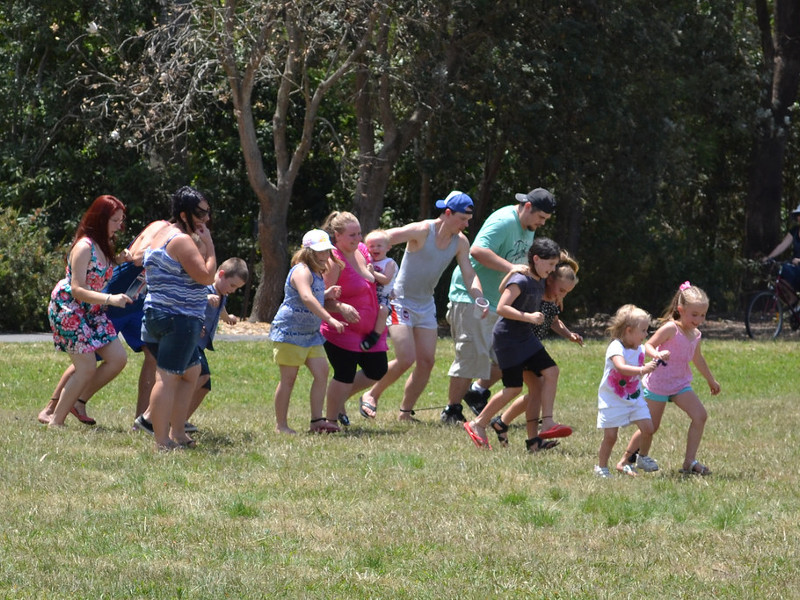The 3 Legged Race is popular at picnics, outdoor events, and team-building activities. Winning tips include synchronizing steps, maintaining balance, and clear communication.
Participation improves teamwork, nurtures camaraderie, and enhances communication skills. The game emphasizes mutual support, shared goals, and working together seamlessly.
Origins of the Three-Legged Race
The three-legged race has a long history dating back to the Middle Ages when it was used to prepare children for the adult world in a fun way.
In the late 19th and early 20th centuries, it was taken seriously as a competitive sport, with athletes like Ernst Schultze and Emil Wernicke from BFC Germania 1888 setting world records for the fastest times, such as 12.8 seconds for the 100-meter distance in 1896.
Although it was once a serious sport, the three-legged race is now mostly enjoyed as a fun and entertaining activity at various events. It is a popular game at children’s parties, youth camps, school festivals, and inclusive events for people of all ages. In school physical education programs, it serves as a playful running and coordination exercise, while in disability sports, it is valued for its therapeutic benefits when done with partners.
Noteworthy achievements include the world record set by Harry L. Hillman and Lawson Robertson in 1906, who completed the slightly longer 110-yard track in just 12.6 seconds. These records and achievements highlight the competitive aspect of the three-legged race in its historical context.
Tips for Winning the Race
To excel in the 3 Legged Race, strategic coordination and effective communication are crucial. Follow these tips for success:
- Sync Steps: Coordinate movements with your partner for a steady pace.
- Balance: Maintain a rhythm that allows both participants to contribute equally.
- Clear Communication: Establish signals to anticipate turns, direction shifts, and obstacles.
Benefits of Participating
Participating in the 3 Legged Race enhances teamwork skills and fosters camaraderie with a partner. The race demands synchronization, communication, and mutual understanding to succeed.
Benefits include strengthening teamwork, improving communication, and developing camaraderie. The event fosters trust, cooperation, clear instructions, active listening, shared memories, and a sense of achievement.
Participants in a three-legged race typically consist of pairs of runners bound together at the lower legs, following specific guidelines to ensure coordination and fair competition. To ensure a smooth and enjoyable race, runners must adhere to certain rules and practices:
| Guideline | Description | Purpose |
|---|---|---|
| Partner Selection | Compatible partners with similar running pace. | Guarantee coordination and mutual understanding. |
| Leg Binding Technique | Secure binding above the ankle for stability. | Prevent tripping and maintain balance. |
| Communication Strategy | Constant communication to synchronize movements. | Coordinate steps and maintain momentum. |
| Equal Effort Distribution | Both partners contribute equally to the race. | Fairness and teamwork for an equitable competition. |
Planning and Preparation
Participating in a Three Legged Race requires careful planning and preparation to ensure a successful event. Consider the following:
- Location: Choose a flat area with ample space for safety.
- Materials: Gather necessary items like straps and cones in advance.
- Team Formation: Pair participants with partners of similar height and weight for better coordination.
Safety Tips
Ensuring a safe environment for participants is essential during the 3 Legged Race, requiring careful attention to potential hazards and appropriate preparation. Before starting the race, it is vital to inspect the racing area for any obstacles or harmful items that could pose a risk to the participants.
Moreover, adjusting the Velcro straps for comfort and proper circulation is pivotal to prevent any discomfort during the race. Participants should wear suitable footwear to guarantee stability and safety throughout the competition. Having supervisors present for assistance adds an additional layer of security and support.
Proper Leg Tying Technique
When preparing for a legged race, mastering the proper leg tying technique is important for safety and efficiency during the event. Properly tying your legs together is essential to maintain balance and prevent accidents.
To achieve this, start by selecting a sturdy material for tying the legs, making sure it is neither too loose nor too tight. Tie the legs securely but without restricting circulation or causing discomfort, using a double knot to ensure the tie remains in place.
Leave enough slack in the tie to allow for natural movement and flexibility while running. Practicing the leg tying technique before the race will help you perfect your method and adjust it according to your comfort and freedom of movement.

Exciting Variations to Try
Investigating different course designs can add a touch of challenge to the classic Three Legged Race experience. To enhance the experience, consider the following variations:
- Obstacle Course: Integrate hurdles or cones to test agility and coordination.
- Timed Races: Race against the clock to add a competitive edge.
- Adult Involvement: Pair adults for a comical twist.
These variations bring new energy to the traditional Three Legged Race, offering participants a chance to break free from the norm and explore new levels of fun and excitement.

